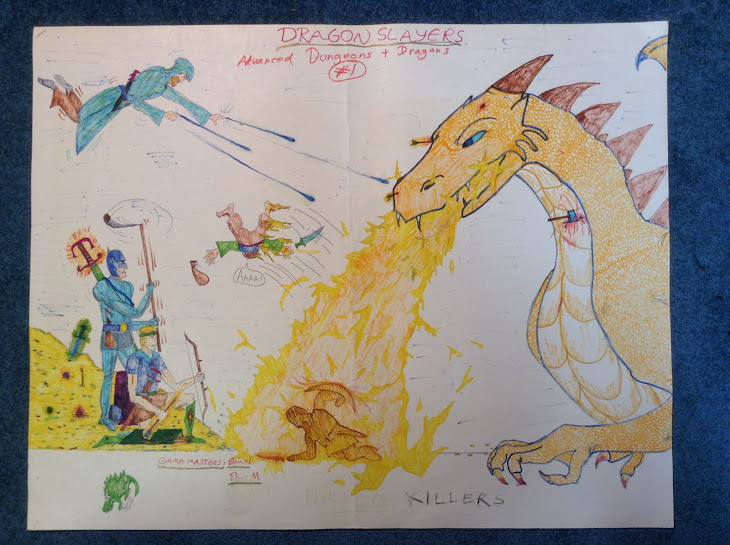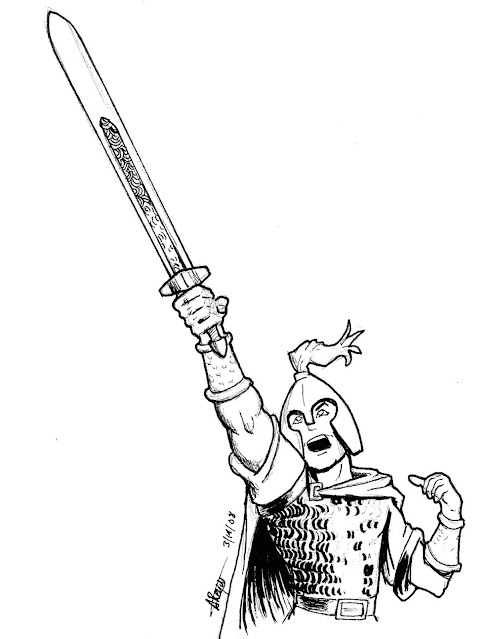Combat obviously is an important element in most fantasy role-playing games. At its best, it’s exciting and dramatic. After all, the protagonists’ lives are at risk! And surprising things can happen – either because of chance (the rolls of the dice) or because of players’ inventiveness (or even inspiration on the part of the Game Master in the midst of a session).
In the two campaigns that I currently am running – both using the Against the Darkmaster (VsD) system, one set in Middle-earth, the other in my home setting of Ukrasia – I rarely have more than one combat in any given session. Thanks to its “critical hits” system, combat in VsD can easily become quite deadly or debilitating, so players tend to avoid it when possible. Hence, two or more sessions (if not more) typically will pass between combats. I like this kind of pacing, as it ensures that when combat does take place, it is noteworthy and memorable.
The two games that I play the most these days – VsD and Mythras – both have involved and colourful combat systems. While VsD has vivid critical hits, fumbles, and the like, Mythras has hit locations and exciting “special effects” (previously called “combat manoeuvres”) that allow for a wide range of tactical options, including defensive ones. They definitely are not “rules light” systems!
Almost two decades ago (!), when I finally realized that I disliked 3rd edition Dungeons and Dragons, I thought that that was because I disliked “rules heavy” FRPGs. But that wasn’t really the case. I’ve always liked certain “rules heavy” – or at least “rules medium” – systems, like Middle-earth Roleplaying and Stormbringer. What I disliked was how tedious the rules for 3e D&D were – both in terms of prep work and its combat system. Running and playing 3e D&D involved a lot of work – and there was very little pay-off for that, as combats in 3e were frequent but usually quite boring. For the most part, characters and their opponents were “blocks of hit points” that would be chipped away during combats that involved a lot of rather flavourless options (and ubiquitous, bland “attacks of opportunity”).
The problem isn’t nearly as bad in 5th edition Dungeons and Dragons. But it’s still there: the game assumes that combat is common (which the DM can ignore, of course) and that it rarely threatens the lives of the characters (thanks to all their abilities, inflated hit points, “death saves,” and the like). (Yes, there are options to make the game more “gritty” and deadly hidden in the Dungeon Master's Guide, but the default mode is very much “fantasy superheroes,” wherein player characters rarely face serious risks.) Combat in 5e D&D is pretty dull in my experience – at least when compared to the alternatives with which I am familiar, such as Mythras and VsD.
So what my recent 5e D&D campaign taught me was that what I dislike are “rules heavy” or “rules medium” systems in which combat is insipid and (usually) not that risky (at least to the characters). I had to work hard to ensure that at least some of the combats in my campaign were novel. In contrast, no such work is needed for Mythras or VsD, given the intrinsic qualities of those combat systems. Even an encounter with some “vanilla” bandits or orcs can be risky and interesting.
That said, sometimes one doesn’t want to engage in a lot of book-keeping when running a game. That’s certainly fine. This is where older (TSR era) editions of D&D and AD&D shine (at least when one isn’t using all the rules outlined by Gary Gyax in the AD&D rules – which almost no one ever did or does). In old school D&D (and associated “retro-clones” like Swords and Wizardry, OSRIC, and Crypts & Things), combat is fast. So while it lacks the colourfulness and tactical depth of other systems, at least it rarely takes more than 20 minutes to resolve (unlike even trivial combats in 3e or 5e D&D). And of course, combat can be more deadly in older versions of D&D, given the lower hit points of characters, the absence of “death saves,” the relative rarity of healing spells, etc.
In short, my view is that combat should be either interesting or fast. One of my gripes with 5th edition D&D is that combat typically is neither (although sometimes it can be), at least in comparison to the other FRPGs that I play.




















